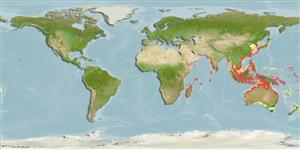Common names from other countries
Environment: milieu / climate zone / depth range / distribution range
Ecologia
marinhas demersal; intervalo de profundidade ? - 70 m (Ref. 39597). Tropical
Indo-West Pacific: southern India to southern China and New Caledonia.
Tamanho / Peso / Idade
Maturity: Lm ? range ? - ? cm
Max length : 13.0 cm TL macho/indeterminado; (Ref. 48635)
Espinhos dorsais (total) : 12 - 15; Raios dorsais moles (total) : 7 - 8; Espinhos anais: 2; Raios anais moles: 5. Geographical differences: specimens from the Gulf of Thailand usually with large blotches over the body; those from Indonesia and Australia generally have less solid markings. Species observed to alter its color from light to dark in captivity. Scales in vertical rows, 44-66 (Ref. 39597).
Found inshore on and around corals and hard bottoms (Ref. 39597), silty and muddy habitats (Ref. 48635). Often taken by nets and handlines (Ref. 39597). Also found in rocky bottoms and coral reef crevices in about 7-70 m (Ref 90102).
Life cycle and mating behavior
Maturities | Reprodução | Spawnings | Egg(s) | Fecundities | Larvas
Paxton, J.R., D.F. Hoese, G.R. Allen and J.E. Hanley, 1989. Pisces. Petromyzontidae to Carangidae. Zoological Catalogue of Australia, Vol. 7. Australian Government Publishing Service, Canberra, 665 p. (Ref. 7300)
Categoria na Lista Vermelha da IUCN (Ref. 130435)
CITES (Ref. 128078)
Not Evaluated
Utilização humana
Pescarias: sem interesse; Aquário: Espécies comerciais
Ferramentas
Relatórios especiais
Descarregue XML
Fontes da internet
Estimates based on models
Preferred temperature (Ref.
115969): 24.4 - 29.1, mean 28.1 (based on 1516 cells).
Phylogenetic diversity index (Ref.
82804): PD
50 = 0.5625 [Uniqueness, from 0.5 = low to 2.0 = high].
Bayesian length-weight: a=0.02399 (0.01270 - 0.04533), b=2.95 (2.78 - 3.12), in cm Total Length, based on LWR estimates for this species & (Sub)family-body (Ref.
93245).
Nível Trófico (Ref.
69278): 3.2 ±0.3 se; based on size and trophs of closest relatives
Resiliência (Ref.
120179): Médio, tempo mínimo de duplicação da população 1,4 - 4,4 anos (Preliminary K or Fecundity.).
Fishing Vulnerability (Ref.
59153): Low vulnerability (10 of 100).
